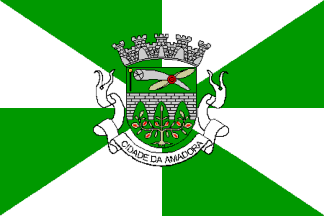
Last modified: 2014-06-29 by klaus-michael schneider
Keywords: amadora | coat of arms: bridge | arches: 3 | windsock | propeller | bush | pomegranate | mina | coat of arms (chief) | windmill wheel | pomegranate | mine | mound: 3 coupeaux |
Links: FOTW homepage |
search |
disclaimer and copyright |
write us |
mirrors

It’s flag is a typical gyronny of green over white with one of the
ugliest coats of amrs in portuguese municipal heraldry, in my humble
opinion. It includes a 5-towered mural
crown (with an unusual shape; all my sources present it this way, so I
guess it’s the way it is used), and a scroll (also unusual) that
reads "CIDADE DA AMADORA". The shield is green,
has in chef a yellowish airplane propeller and a silver windsock, then
an aqueduct and below a pomegranate tree also in that yellowish colour
of the propeller, with fruits with something red within.
Jorge Candeias, 25 Jul 1998
At the present time Amadora does not have any airfield. However, in
the 1920s a small airfield (the 1st in Portugal) was located here. The
first air-travel from Portugal to Brazil had is departure from Amadora.
The Captain of the airplane was Adm. Gago Coutinho, a well knowned
Portuguese celebrity. This justifies the airplane propeller and a silver
windsock on the Amadora’s flag.
Jorge Fernandes, 15 Apr 2003
The arches represent
the famous Free Waters Aqueduct (Aqueduto das Águas Livres),
which brings water from Sintra hills to
Lisbon, streching some 30 km through these three
municipalities. It was finished in the 1770ies and includes the largest
masonry only arch ever built, located in the
Campolide commune — local coat of arms also
displays the aqueduct (like others along its way).
António Martins, 20 Sep 1998
The tree is a pomegranate tree, one of the Amadora symbols. The explanation is somewhat awkward, and hard to explain in English, but it follows:

Green and white gyronny.
Jorge Candeias, 14 Jul 1999
Amadora is a dormitory city of Lisbon, one of the smallest portuguese
municipalities (24 km²), and one of the most populated (187 000 inh.;
175 534 in 2000, cesus data) divided in 8 communes.
It is placed to the northwest of Lisbon, in its
district and in the old
province of Estremadura, future
Lisboa-e-Setúbal region.
Jorge Candeias, 25 Jul 1998
The former commune was dettached from the Oeiras
municipality on 11 September 1979. At once was created the
municipality of Amadora and the town was promoted to the rank of
city.
Francisco Santos, 16 Apr 2003

It is a fairly typical portuguese communal flag,
with the coat of arms centered on a
plain white background. The banner should have
silvery and green tassels and cord, and golden pole and spear finial.
Flag and arms adopted and published in the official journal
Diário da República : III
Série in 1997.02.06.
António Martins, 15 Aug 2008
.gif)
The arms are Argent three windmill wheels of eight arms Sable dressed Gules set in fess and issuant from the base three mounds Vert with the middle one charged with a mine entrance Argent masoned Sable open and litten of two windows Sable and on a chief Vert a pommegrenate tree Argent erradicated and fruited of the Same and the fruits cracked Gules. Mural crown argent with three visible towers (commune rank) and white scroll reading in black upper case letters "Mina -Amadora". Original blazon:
Escudo de prata, três montes de verde, moventes da ponta e, sobreposto a cada um, uma armação de moinho de negro, vestida e cordoada de vermelho, o monte do centro carregado com um entrada de mina de prata, lavrada de negro, com a porta e duas janelas do mesmo; chefe de verde, carregado de uma romãzeira arrancada de prata, frutada do mesmo e com os frutos rachados de vermelho. Coroa mural de prata de três torres. Listel branco com a legenda a negro, em maiúsculas: "MINA - AMADORA".António Martins, 15 Aug 2008
Plain (monocolored) portuguese subnational flags are
not allowed to have armless
variations: plain flags always carry the coat of arms.
Jorge Candeias, 18 Jul 1999
Mina Commune was created in 1997, dettached from São Brás Commune;
it is one of the eleven communes of the Amadora
Municipality; it had 18 915 inhabitants in 2001 and covers
2,76 km².
"Mina" is Portuguese for "mine", of which there is a denotative
canting element in the arms; in this case, though, it stands for a "water
mine", i.e. a natural spring. A faithful depiction of a
local
landmark is shown which is against
legal prescription.
António Martins, 15 Aug 2008
Anything below this line was not added by the editor of this page.